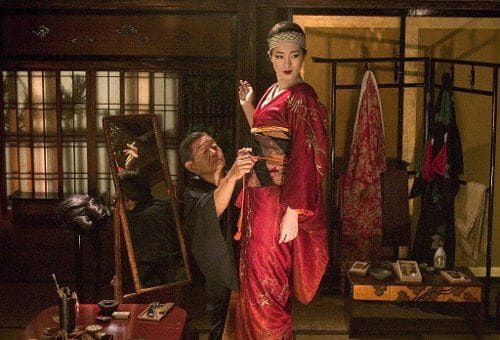Eye For Film >> Movies >> Memoirs Of A Geisha (2005) Film Review
Memoirs Of A Geisha
Reviewed by: Chris

It would be lovely to find a beautiful verse to speak to the spirit of a geisha's memoirs.
The butterfly is perfuming Its wings in the scent Of the orchid

This haiku (a 17 syllable epigrammatic verse) by one of Japan's greatest poets (Basho Matsuo) seems at first glance to have little to it. So runs much of Japanese art, perfected to painstaking rules and discipline, yet requiring a degree of learning simply to appreciate, although soul piercing when understood.
In (the American made) Memoirs Of A Geisha, we must be forgiven for expecting some aid to understanding, some hint of passion, for the difficult-to-fathom and obscure world of Japan, of geisha, of those representatives of artistic excellence and recipients of passionate devotion, women who underwent training (willingly, or not) that might be compared in rigour to that of a ballerina and maybe also some reference to what in times past has been a less glamorous side to their institution and one that is often personified in the Western stereotype.
Japan and America. are similar in one respect. Both are geographically and culturally fairly isolated. Common language and considerable wealth have greatly assisted the US in assimilating much artistry from overseas, but are a disadvantage to Japan in as much as it has never had to accept another culture for its own survival.
On one trip to Japan, I was pleasantly amused by young men at a conference coming up and practicing their handshakes. They would wring my hand intently, as if honouring it with a special physical therapy technique, and then glance up before bowing, hoping they had "got it right." I was moved by the effort they had made to be polite in terms of my own culture, even if they were way off mark, especially as my abilities in the (fairly technical) art of Japanese bowing were minimal. American and Japanese understanding of goodwill could not be more directly opposite if it tried. Shortly after this incident, I noticed (in better Japanese hotels) boxes for Americans who insist on tipping, a practice generally considered rude in Japan, as it implies the recipient is inferior and in need of patronage. (They get round the problem by giving the tips box to charities).
With such contrasts in basic understanding, for a US film studio to take on a subject shrouded in inscrutability, even in Japan, especially based on Arthur Golden's bestseller, which, although sensitively received, has had a fair amount of criticism, is a massive undertaking. They have gone to considerable lengths, bringing in top Asian actors, a decorated director and cinematographer, as well as music by the multi-accoladed John Williams, with solos by leading classical musicians. After all this care and sympathy, how does the film stand up?
Firstly, it is visually stunning, not only with rural and urban scenery rarely seen in the West, but with impressive use of colour and lighting. In one scene, as Sayuri makes her debut in a leading part at the theatre, we are treated to a fabulous dramatic entrance, suggesting classical posture and make-up. Little expense has been spared. It is the bright lights and fast cameras that director Rob Marshall used to such effect in Chicago.
We follow a young girl from the time she is sold by her parents, through her apprenticeship and graduation as a geisha and then through the onset of war and its aftermath. It has the exotic appeal of, say, The King And I, or other successful movies that use an unknown culture to bring spice to a simple love story. It will delight many audiences. But, as something more serious, it plummets as fast as a wingless bird.
Although there are moments of tension, such as the theatre performance, or the jealous rage of a competitor geisha, much of the pacing (especially in the first third) is lacklustre, like someone telling a story at a continuous pace (much of the background is told in voiceover). Opportunities for dramatic excitement are easily missed with such a format. Telling the story takes so much time, there is little left for character development, so it is hard to identify with the pain and triumphs of even the main lead.
A very modest brush with Japanese culture is sufficient to inform the viewer that this movie lacks authenticity in its most crucial aspects. Even Holden's novel gives a token indication of the degree of work necessary to get things like Japanese dance right. You cannot cast a film star in a part that requires a lifetime study, or the equivalent of a university degree, to pull off without considerable technical finesse. It would be like asking Richard Gere to dance a couple of scenes from Nureyev's repertoire.
It gets worse. The day-to-day details are incredibly sloppy and unreflective of Japanese culture. To Westerners that have spent little time in the Far East, Thai, Korean, Chinese and Japanese may all seem very similar. Yet Chinese body language, mannerisms and accents are about as similar to Japanese as Australians are to the Scots. Most obviously perhaps, the make-up employed by the film's "geisha" is instantly recognisable as quite ordinary, not the sort that takes hours to apply.
In A Beautiful Mind, director Ron Howard took an arcane and mysterious subject (mathematics) and made it exciting to non-mathematicians. Other directors have dealt similarly with obscure arts or strange worlds and let us glimpse a hitherto unknown region, often adding a good love story, or other dynamic elements, for good measure. Producer Steven Spielberg, however, confesses to a different objective: "I was very moved by the love story, by the rivalry . . . and by the test of friendship." Japanese culture is mentioned only in passing. The aim was not to introduce us to something new but something that's "relevant to people in every county."
In other words, they gave up before they started. Instead of highly developed Japanese traditions, they went for lowest common denominators and even there the "love story" fails to stand up as the context (a society of arranged marriages) is imperfectly explained. What we have is the equivalent of an American girl, who goes from nothing to become a high-class prostitute, accepting a few offerings from someone who feels something for her. Change the country, add a mix of oriental costumes and languages, plus homage to a well-known book and lots of highly paid talent that sadly lacks artistic integrity and you have a winning Hollywood formula.
It is one thing to "include" lurid details, such as the auctioning of a maidenhead; it is another to miss the main point. Imagine telling the story of a great blues singer, but only dwelling on the horrors and transition from slavery, and using an actor who couldn't sing. Or an early Russian dancer, while only dwelling on the privations and cruelty inflicted by his training. You would be forgiven for saying, like a group of Balinese dancers seeing ballet for the first time, "Well, it's very pretty, but it's not really dancing."
Has the film really missed such an opportunity? Are we not lucky to have a hint, even a flawed one, of this mysterious world? It might be a question worth examining, especially to see if it is not just a well-meaning goof, but actually an insult to Japanese culture.
Geishas have their roots in female entertainment since before the 13th century. They would perform for the nobility and some even became concubines to the emperor. The earliest "geiko," or "geisha," were men, while the first females, who appeared shortly after, were dancers, or musicians. Female geishas soon became popular enough to be able to steal clients from the courtesans. They flourished as artists and entertainers and soon became regarded as fashion leaders, perhaps, in some ways, on a par with Western "supermodels."
Girls who wish to become a geisha have to go through a rigid apprenticeship, during which they learn various traditional arts, such as playing instruments, singing, dancing, but also conversation and other social skills. In Japan, even today, geishas are accorded considerable respect for their accomplishments and for what they represent. Being in the presence of a geisha is a remarkable experience. As if royalty has suddenly walked into the room, one feels thrown against the wall with a sense of awe.
Training is long and exacting and, like that of the Western ballet dancer, ideally undertaken at a young age, although this traditional length of apprenticeship rarely happens today. It involves a tremendous cost, as do accessories, such as kimonos. Geishas were, and are, consequently a very elite group and their presence, for instance at social functions, is very expensive. A man seeking a beautiful courtesan, or a mere hostess, could find one at a fraction of the price. Girls wishing to become a geisha today are usually interested in preserving traditional Japanese arts but, apart from the abuses of human rights that have been abolished, are the same experts in the finer arts that they always have been.
One should not be too hard on the American producers of the film. They have excellent explanations as to why things were done the way they were and are full of good intentions. But artistic integrity is not won with good intentions (and a large bankroll). Memoirs Of A Geisha is Americanised Japanese culture, marketed like a Spielberg franchise.
The film is a tantalising taste of something it is not, neither informitive, nor satisfactory, although sumptuously, if simplistically, entertaining. It will please many less discerning audiences, as well as critics, or voters for awards, who review a movie by means of watching it on DVD - it has a lush play of colour that will transfer to the small screen together with a low attention-span requirement that allows you to make the coffee. However, it is about as far from the memoirs of any geisha as the instant coffee will be from the beautiful ritual of the Japanese tea ceremony.
The film, like a Japanese haiku, seems to have little to it: unlike a Japanese haiku though, it really doesn't.
Reviewed on: 13 Jan 2006



















